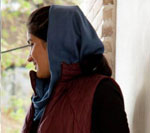 Fox News: Many young Iranians have become emboldened in how they walk the streets, showing an affinity for Western clothing, jewelry, makeup and hairstyles. But it is more than just a fashion statement, say Iranians. It’s a political statement.
Fox News: Many young Iranians have become emboldened in how they walk the streets, showing an affinity for Western clothing, jewelry, makeup and hairstyles. But it is more than just a fashion statement, say Iranians. It’s a political statement.
By Lisa Daftari
FoxNews.com

The regime in Tehran is increasingly feeling the pressure, but not from sanctions or the threat of a military strike.
It’s a vibrant and growing fashion scene, one that enables Iranians to defy the strict religious leaders who have ruled the nation with an iron fist since the 1979 revolution.
Many young Iranians have become emboldened in how they walk the streets, showing an affinity for Western clothing, jewelry, makeup and hairstyles. But it is more than just a fashion statement, say Iranians. It’s a political statement.
“Violating the dress code is another way young Iranians can express political dissent,” said journalist and political activist Mansoureh Nasserchian.
Since the 2009 uprisings, when Iranians flooded the streets of Iran protesting the corruption of their government in the aftermath of former President Mahmoud Ahmadinejad’s contested re-election, the world was introduced to a new brand of Iranians influenced by social media and Western styles and ideologies, according to Nasserchian, who fled the country for Canada shortly after the uprisings.
“Violating the dress code is another way young Iranians can express political dissent.”
– Mansoureh Nasserchian, political activist
“When the young people filled the streets, not caring how they dressed or if they had hair covering, things really changed in Iran,” Nasserchian said. “Social media gave the courage to the new generation to break taboos and be open about political and social issues.”
Dubbed the “Twitter Revolution,” this political movement had strong social underpinnings, demonstrating the unwavering desires of a new generation of young, savvy, technology-driven young people who were now Iran’s political opposition.
But as the fashion statements became louder, the regime has become sharply aware and crackdowns are now more frequent.
The government has launched a “soft war” against all cultural and technological influences that are imported into the country. This means frequent crackdowns on elements that represent Western life, including clothes, hairstyles, pets, movies, music and the Internet. In recent years, Tehran has spent heavily to combat these “un-Islamic influences” through morality police, cyber police and government bans.
But this has not stopped an overwhelmingly Western-loving and young population of Iranians from gravitating toward American and European styles.
“We believe the first sentence you say is the way you look, so every Iranian wants to express a sentence which is completely different from other Iranians,” said Mojgan, a fashion blogger living in Iran, who asked not to be identified by her real name.
Western brand names continue to be more popular among Iranian youth, but over the past few years, a deteriorating economy inside Iran shifted the focus to local fashion designers.
“Iranian designers get influences from Western designers, especially France, Italy, the UK and the U.S., and work to keep Islamic guidelines. But in Iran wearing fashion is very important,” Mojgan said.
A boutique owner in Tehran, who asked not to be identified by her name or the name of her business, said the morality police came in to ask why the mannequins in her storefront were not wearing the hijab, the traditional Islamic headscarf that all women are required to wear.
“I mean really, the mannequins?” she said. “They have to have hijab? Where are we living?”
Women in Iran are required to have their hair covered, usually by a scarf. They cannot wear clothing that exposes their arms and must wear a manteaux, or overcoat of some type, that covers three-quarters of the body. They also must wear floor-length skirts, forbidden from showing any of their leg.
Even now, under new President Hassan Rouhani, a self-proclaimed moderate, many Iranians say the morality police are just as harsh as before, approaching Iranians who are not properly dressed in public.
“In terms of fashion, this and previous government are the same,” Neda, a 43-year-old lifestyle blogger from Tehran, said.
“The crackdowns become worse every summer as dresses get shorter, fabrics become thinner and Iranians are out in the streets wearing bright colors and Western-style hair,” she said.


